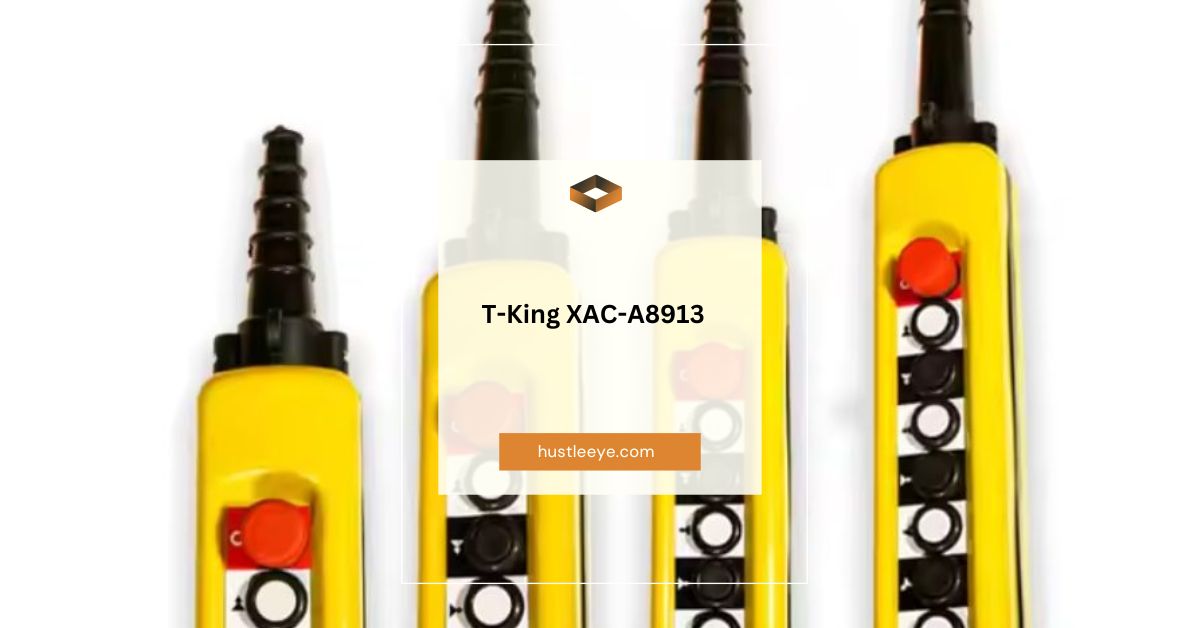In the world of industrial automation and control systems, the T-King XAC-A8913 plays a crucial role. It’s a versatile and robust control device used across various industries to manage machinery and direct equipment operations. To fully utilize the T-King XAC-A8913, it’s essential to understand its schematic diagram. This guide delves into every aspect of the “T-King XAC-A8913 diagram,” providing you with a clear, easy-to-understand explanation of its components, connections, and functions.
Table of Contents
What is the T-King XAC-A8913?
Before diving into the intricacies of the T-King XAC-A8913 diagram, it’s important to understand what the T-King XAC-A8913 is. The T-King XAC-A8913 is a control device specifically designed for industrial automation. It acts as the brain of machinery, controlling operations by sending signals to various components like motors, sensors, and actuators. This device is built to withstand harsh industrial environments, making it a reliable choice for a range of applications.
Read More: Working Out With Two Guys: Romina Boudoir’s Comprehensive Guide to Trio Fitness
Why is the T-King XAC-A8913 Diagram Important?
Understanding the T-King XAC-A8913 diagram is crucial for several reasons:
- Proper Installation: The diagram provides clear guidance on how to connect the device correctly, ensuring that all components are properly wired and reducing the risk of errors.
- Troubleshooting: When issues arise, the diagram serves as a roadmap for diagnosing and resolving problems, saving time and reducing downtime.
- Integration: For those integrating the T-King XAC-A8913 into larger systems, the diagram offers insight into how it connects with other devices, ensuring seamless communication and functionality.
Read More: The Rise of Thejavasea.me Leaks AIO-TLP: A Digital Revolution in Data Access
Breaking Down the T-King XAC-A8913 Diagram:
The T-King XAC-A8913 diagram can seem complex at first glance, but it becomes manageable when broken down into its key components. Let’s explore each section of the diagram in detail.
1. Power Connections:
1.Power Supply Requirements:
The T-King XAC-A8913 requires a stable power supply to function correctly. The diagram will indicate the specific power input terminal, typically labeled as L (Live), N (Neutral), and G (Ground). Ensuring the correct voltage is supplied is crucial to prevent damage to the device.
2. Connecting the Power Supply:
- Turn Off Power: Before making any connections, ensure the power is off to avoid electric shocks or short circuits.
- Connect Live Wire: Attach the live wire to the L terminal.
- Connect Neutral Wire: Connect the neutral wire to the N terminal.
- Connect Ground Wire: Finally, connect the ground wire to the G terminal.
By following the diagram’s instructions, you can ensure that the T-King XAC-A8913 receives the correct power supply, which is critical for its operation.
Read More: Myliberla.com: Protection, Community, and Continuous Learning
2. Input/Output Ports:
1. Understanding Input Ports:
Input ports are where the T-King XAC-A8913 receives information from sensors and switches. These inputs are crucial for the device to understand the state of the machinery it’s controlling.
- Sensors: Sensors can include temperature sensors, pressure sensors, or any other type of sensor that provides data to the T-King XAC-A8913.
- Switches: These are manual inputs, such as buttons or toggles, that can be used to control machinery directly.
2. Understanding Output Ports:
Output ports are where the T-King XAC-A8913 sends signals to actuators or indicators. These outputs control the physical components of the machinery.
- Actuators: These could be motors, solenoids, or other devices that perform physical actions in response to signals from the T-King XAC-A8913.
- Indicators: These outputs might drive visual indicators like lights or auditory indicators like alarms.
3. Connecting Inputs and Outputs:
- Identify Ports: Use the diagram to identify the correct input and output ports for your sensors and actuators.
- Wire Appropriately: Connect the wires from your sensors or actuators to the corresponding ports on the T-King XAC-A8913.
- Verify Connections: Double-check that all connections match the diagram to ensure proper functionality.
Read More: Unleashing the Power of https:// workink.co/2hk/aimmyv2: Revolutionizing Modern Workflows
3. Communication Interfaces:
1. Types of Communication Interfaces:
The T-King XAC-A8913 is equipped with various communication interfaces that allow it to interact with other systems or devices.
- RS-232/RS-485: These serial communication ports are commonly used for connecting to other control systems or devices. RS-485, in particular, is favored for its ability to transmit data over longer distances at higher speeds.
- Ethernet: An Ethernet interface allows the T-King XAC-A8913 to connect to a network, facilitating communication with other devices in a larger system.
2. Connecting Communication Interfaces:
- Locate Interface Ports: Refer to the diagram to locate the communication interface ports.
- Select Appropriate Cables: Depending on the type of interface (e.g., RS-485, Ethernet), choose the correct cables.
- Secure Connections: Connect the cables securely to ensure stable communication.
- Configure Settings: Adjust settings as needed to ensure proper communication with connected devices.
Read More: The Oneworldcolumn.org Blog: A Comprehensive Guide for USA Readers
4. Internal Components:
The internal components of the T-King XAC-A8913 are crucial to its operation. Understanding these components helps in troubleshooting and ensuring that the device functions correctly.
1. Key Internal Components:
- Relays: These are used to switch electrical circuits within the T-King XAC-A8913. Relays allow the device to control high-power circuits with a low-power signal.
- Processors: The processor is the brain of the T-King XAC-A8913, handling logic operations and making decisions based on input data.
- Power Circuits: These circuits distribute power to the various components of the T-King XAC-A8913, ensuring each part has the necessary power to operate.
2. Understanding Internal Components:
- Relays: Ensure relays are properly interconnected to handle the required switching operations.
- Processors: Make sure the processor is operating within the specifications required for your application.
- Power Circuits: Verify that power is being distributed correctly according to the diagram.
Read More: GDP – Deleted Scene – E355: Unveiling the Hidden Layers of Economic Analysis
5. External Connections:
1. Connecting External Devices:
The T-King XAC-A8913 often needs to connect to external devices or systems as part of a larger industrial setup.
- Refer to Diagram: Identify the correct external connection points on the diagram.
- Choose the Right Cables: Use cables that match the specifications provided in the diagram.
- Make Connections: Carefully connect external devices, ensuring all connections are secure and correct according to the diagram.
Read More: Discover Everything You Need to Know About Pethardas.com
6. Functional Blocks:
Functional blocks are sections of the T-King XAC-A8913 diagram that represent different parts of the device and how they interact.
1. Types of Functional Blocks:
- Input Processing: These blocks process data received from input devices like sensors.
- Control Logic: This section performs logical operations on the input data and makes decisions.
- Output Control: These blocks manage the signals sent to output devices like actuators.
2. Understanding Functional Blocks:
- Determine Functions: Identify the function of each block by studying the diagram.
- Follow Data Flow: Understand the flow of data between blocks to ensure proper operation.
- Check Configuration: Ensure each block is configured correctly according to the requirements of your application.
Read More: Get ThriftyEvents.net Blog: The Ultimate Guide to Budget-Friendly Living and Event Planning
Practical Tips for Working with the T-King XAC-A8913 Diagram:
1. Follow the Diagram Carefully:
Always refer to the T-King XAC-A8913 diagram during installation or troubleshooting to ensure accuracy.
2. Use Proper Tools:
Make sure you have the necessary tools for wiring and connecting the T-King XAC-A8913. Using the correct tools reduces the risk of errors and damage.
3. Consult the Manual:
In addition to the diagram, the T-King XAC-A8913 manual is a valuable resource for understanding specific details about the device. It often contains troubleshooting tips and detailed explanations of the diagram.
4. Double-Check Connections:
Before powering up the T-King XAC-A8913, double-check all connections to ensure they match the diagram. This can prevent damage to the device and connected components.
Read More: GLNG Game Acronym: An In-Depth Exploration
Frequently Asked Questions (FAQs):
1. What is the purpose of the T-King XAC-A8913?
The T-King XAC-A8913 is a control device used in industrial automation to manage and direct machinery operations. It controls various components like motors, sensors, and actuators, ensuring the smooth operation of industrial equipment.
2. Why is understanding the T-King XAC-A8913 diagram important?
The diagram is essential for correct installation, troubleshooting, and integration of the T-King XAC-A8913 into larger systems. It provides a visual guide to the connections, internal components, and functions of the device.
3. What are the key components shown in the T-King XAC-A8913 diagram?
The diagram typically includes power connections, input/output ports, communication interfaces, internal components (such as relays and processors), external connections, and functional blocks.
4. How do I connect the T-King XAC-A8913 to external devices?
Refer to the diagram to identify the correct external connection points. Use the appropriate cables and ensure all connections are secure and match the diagram’s specifications.
5. Can I use the T-King XAC-A8913 in harsh industrial environments?
Yes, the T-King XAC-A8913 is designed to withstand harsh industrial environments, making it a reliable choice for various applications.
6. What should I do if the T-King XAC-A8913 is not functioning correctly?
If the device is not functioning correctly, consult the diagram and manual to troubleshoot the issue. Double-check all connections, verify the power supply, and ensure that all components are correctly configured.
7. Where can I find more detailed information about the T-King XAC-A8913?
The T-King XAC-A8913 manual is a comprehensive resource that provides detailed information about the device, including its diagram, installation instructions, and troubleshooting tips.
Conclusion:
The T-King XAC-A8913 is a powerful and versatile control device that plays a crucial role in industrial automation. Understanding its diagram is key to ensuring proper installation, troubleshooting, and integration into larger systems. By breaking down the diagram into its core components and providing practical tips, this guide aims to make the T-King XAC-A8913 diagram more accessible and easier to understand.
Whether you are a technician, engineer, or anyone working with the T-King XAC-A8913, this guide provides the information you need to make the most of this robust control device. With a clear understanding of the diagram, you can ensure the smooth operation and longevity of your industrial equipment.


